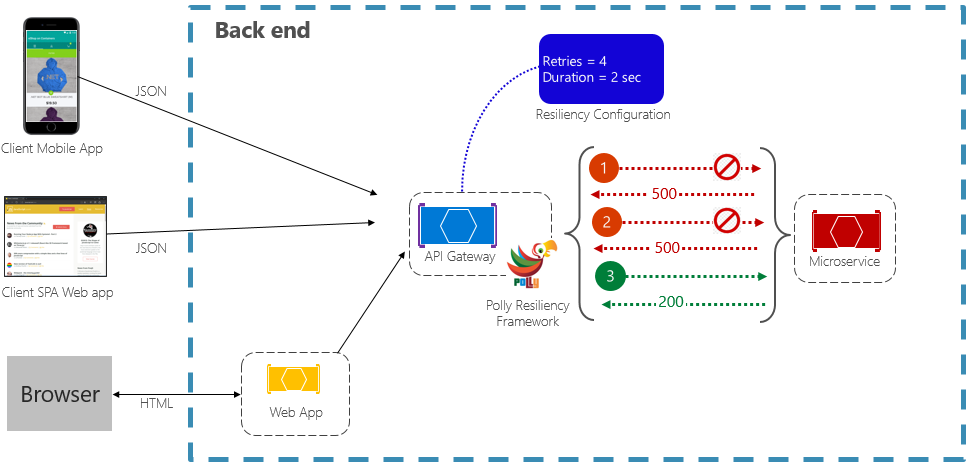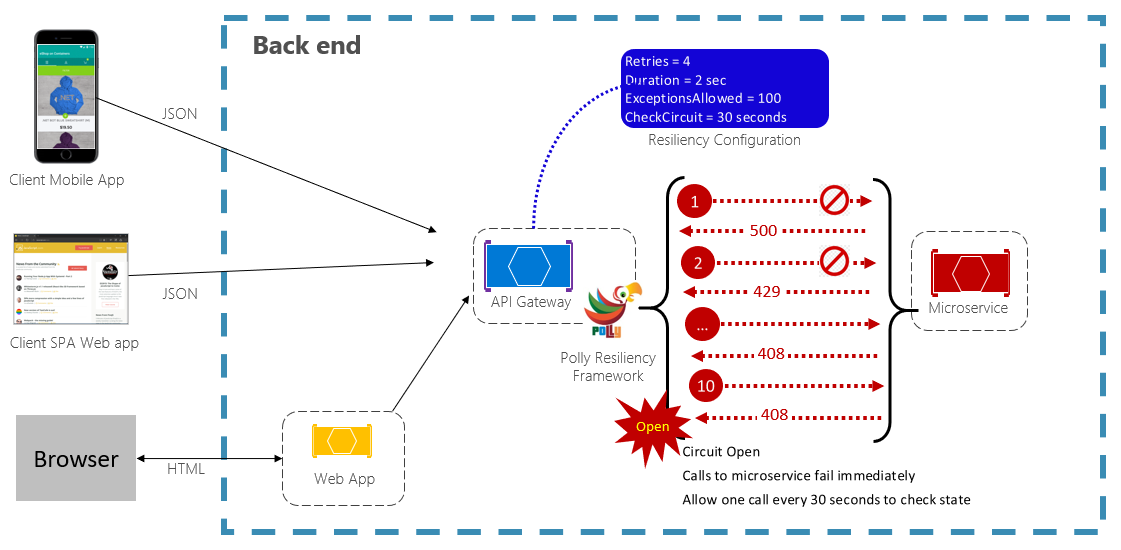Note
Access to this page requires authorization. You can try signing in or changing directories.
Access to this page requires authorization. You can try changing directories.
Tip
This content is an excerpt from the eBook, Architecting Cloud Native .NET Applications for Azure, available on .NET Docs or as a free downloadable PDF that can be read offline.

The first line of defense is application resiliency.
While you could invest considerable time writing your own resiliency framework, such products already exist. Polly is a comprehensive .NET resilience and transient-fault-handling library that allows developers to express resiliency policies in a fluent and thread-safe manner. Polly targets applications built with either .NET Framework or .NET 7. The following table describes the resiliency features, called policies, available in the Polly Library. They can be applied individually or grouped together.
| Policy | Experience |
|---|---|
| Retry | Configures retry operations on designated operations. |
| Circuit Breaker | Blocks requested operations for a predefined period when faults exceed a configured threshold |
| Timeout | Places limit on the duration for which a caller can wait for a response. |
| Bulkhead | Constrains actions to fixed-size resource pool to prevent failing calls from swamping a resource. |
| Cache | Stores responses automatically. |
| Fallback | Defines structured behavior upon a failure. |
Note how in the previous figure the resiliency policies apply to request messages, whether coming from an external client or back-end service. The goal is to compensate the request for a service that might be momentarily unavailable. These short-lived interruptions typically manifest themselves with the HTTP status codes shown in the following table.
| HTTP Status Code | Cause |
|---|---|
| 404 | Not Found |
| 408 | Request timeout |
| 429 | Too many requests (you've most likely been throttled) |
| 502 | Bad gateway |
| 503 | Service unavailable |
| 504 | Gateway timeout |
Question: Would you retry an HTTP Status Code of 403 - Forbidden? No. Here, the system is functioning properly, but informing the caller that they aren't authorized to perform the requested operation. Care must be taken to retry only those operations caused by failures.
As recommended in Chapter 1, Microsoft developers constructing cloud-native applications should target the .NET platform. Version 2.1 introduced the HTTPClientFactory library for creating HTTP Client instances for interacting with URL-based resources. Superseding the original HTTPClient class, the factory class supports many enhanced features, one of which is tight integration with the Polly resiliency library. With it, you can easily define resiliency policies in the application Startup class to handle partial failures and connectivity issues.
Next, let's expand on retry and circuit breaker patterns.
Retry pattern
In a distributed cloud-native environment, calls to services and cloud resources can fail because of transient (short-lived) failures, which typically correct themselves after a brief period of time. Implementing a retry strategy helps a cloud-native service mitigate these scenarios.
The Retry pattern enables a service to retry a failed request operation a (configurable) number of times with an exponentially increasing wait time. Figure 6-2 shows a retry in action.

Figure 6-2. Retry pattern in action
In the previous figure, a retry pattern has been implemented for a request operation. It's configured to allow up to four retries before failing with a backoff interval (wait time) starting at two seconds, which exponentially doubles for each subsequent attempt.
- The first invocation fails and returns an HTTP status code of 500. The application waits for two seconds and retries the call.
- The second invocation also fails and returns an HTTP status code of 500. The application now doubles the backoff interval to four seconds and retries the call.
- Finally, the third call succeeds.
- In this scenario, the retry operation would have attempted up to four retries while doubling the backoff duration before failing the call.
- Had the 4th retry attempt failed, a fallback policy would be invoked to gracefully handle the problem.
It's important to increase the backoff period before retrying the call to allow the service time to self-correct. It's a best practice to implement an exponentially increasing backoff (doubling the period on each retry) to allow adequate correction time.
Circuit breaker pattern
While the retry pattern can help salvage a request entangled in a partial failure, there are situations where failures can be caused by unanticipated events that will require longer periods of time to resolve. These faults can range in severity from a partial loss of connectivity to the complete failure of a service. In these situations, it's pointless for an application to continually retry an operation that is unlikely to succeed.
To make things worse, executing continual retry operations on a non-responsive service can move you into a self-imposed denial of service scenario where you flood your service with continual calls exhausting resources such as memory, threads and database connections, causing failure in unrelated parts of the system that use the same resources.
In these situations, it would be preferable for the operation to fail immediately and only attempt to invoke the service if it's likely to succeed.
The Circuit Breaker pattern can prevent an application from repeatedly trying to execute an operation that's likely to fail. After a pre-defined number of failed calls, it blocks all traffic to the service. Periodically, it will allow a trial call to determine whether the fault has resolved. Figure 6-3 shows the Circuit Breaker pattern in action.

Figure 6-3. Circuit breaker pattern in action
In the previous figure, a Circuit Breaker pattern has been added to the original retry pattern. Note how after 100 failed requests, the circuit breakers opens and no longer allows calls to the service. The CheckCircuit value, set at 30 seconds, specifies how often the library allows one request to proceed to the service. If that call succeeds, the circuit closes and the service is once again available to traffic.
Keep in mind that the intent of the Circuit Breaker pattern is different than that of the Retry pattern. The Retry pattern enables an application to retry an operation in the expectation that it will succeed. The Circuit Breaker pattern prevents an application from doing an operation that is likely to fail. Typically, an application will combine these two patterns by using the Retry pattern to invoke an operation through a circuit breaker.
Testing for resiliency
Testing for resiliency cannot always be done the same way that you test application functionality (by running unit tests, integration tests, and so on). Instead, you must test how the end-to-end workload performs under failure conditions, which only occur intermittently. For example: inject failures by crashing processes, expired certificates, make dependent services unavailable etc. Frameworks like chaos-monkey can be used for such chaos testing.
Application resiliency is a must for handling problematic requested operations. But, it's only half of the story. Next, we cover resiliency features available in the Azure cloud.
